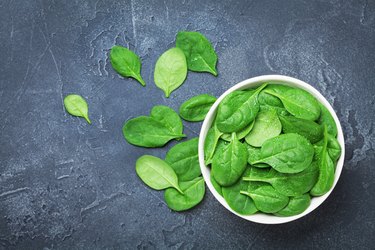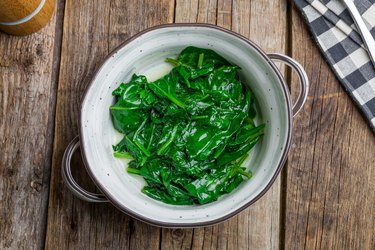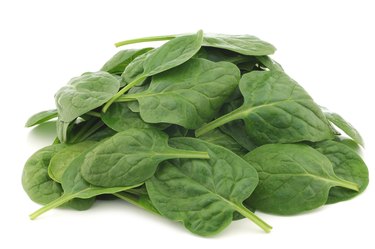Lasagna, a culinary masterpiece that tantalizes taste buds with its layers of savory goodness, often incorporates the vibrant green hues of spinach. However, a question lingers among aspiring lasagna enthusiasts: should spinach be subjected to the heat of a pan before gracing the lasagna’s assembly? To unravel this culinary mystery, we embark on a journey through the depths of culinary wisdom and practical experience.
The Case for Pre-Cooking Spinach: Unveiling the Benefits
Pre-cooking spinach before incorporating it into a lasagna offers several advantages that can elevate the final dish:
-
Moisture Management: Spinach, brimming with its natural moisture, can release excess water during the lasagna’s baking process. Pre-cooking allows this excess moisture to evaporate, preventing the lasagna from becoming soggy and compromising its structural integrity.
-
Flavor Concentration: The heat of the pan intensifies the spinach’s inherent flavors, resulting in a more pronounced and delectable taste experience.
-
Texture Optimization: Pre-cooking spinach renders it more tender, ensuring that it seamlessly blends with the other lasagna components without overpowering their distinct textures.
The Case for Raw Spinach: Embracing the Natural State
While pre-cooking spinach offers certain benefits, some culinary enthusiasts advocate for using raw spinach in lasagna, citing its vibrant color and unadulterated flavor:
-
Color Preservation: Raw spinach retains its vibrant green hue, adding a visually appealing element to the lasagna.
-
Flavor Integrity: Raw spinach imparts a fresh, herbaceous flavor that complements the other lasagna ingredients without undergoing any alterations from pre-cooking.
-
Time Efficiency: Using raw spinach eliminates the additional step of pre-cooking, saving time in the kitchen.
Striking a Balance: A Hybrid Approach to Spinach Incorporation
For those seeking a compromise between the benefits of pre-cooked and raw spinach, a hybrid approach offers a harmonious solution:
-
Partial Pre-Cooking: Wilt the spinach briefly in a pan with a touch of oil, allowing it to release some of its moisture while preserving its vibrant color and fresh flavor.
-
Layering Technique: Alternate layers of pre-cooked and raw spinach in the lasagna, creating a textural and flavor contrast that tantalizes the palate.
Additional Tips for Spinach Lasagna Success
Beyond the pre-cooking decision, several additional tips can enhance the preparation and enjoyment of spinach lasagna:
-
Choose High-Quality Spinach: Opt for fresh, vibrant spinach with crisp leaves to ensure the best flavor and texture.
-
Drain Thoroughly: Whether using pre-cooked or raw spinach, ensure it is thoroughly drained to prevent excess moisture from compromising the lasagna’s consistency.
-
Season Generously: Enhance the spinach’s flavor by seasoning it with salt, pepper, and a touch of garlic powder or Italian seasoning.
-
Experiment with Variations: Explore different spinach varieties, such as baby spinach or Savoy spinach, to add unique flavors and textures to the lasagna.
The decision of whether or not to pre-cook spinach for lasagna ultimately rests upon personal preference and the desired outcome. Pre-cooking offers advantages in moisture control, flavor concentration, and texture optimization, while using raw spinach preserves color, flavor integrity, and saves time. A hybrid approach, combining pre-cooked and raw spinach, provides a harmonious balance of benefits. With careful preparation and attention to detail, spinach lasagna emerges as a culinary masterpiece, delighting taste buds and satisfying culinary aspirations.
Cook Fresh Spinach Lasagna
Spinach is a nutritional powerhouse. According to a fact sheet from Colorado State University, spinach is a low-calorie, nutrient-dense food that can be added to a variety of recipes or eaten raw in salads.
Video of the Day
In addition to being rich in minerals like manganese, magnesium, calcium, zinc, and iron, spinach is also a good source of vitamins A, C, and folate. It is also a good source of fiber. In addition, spinach contains flavonoids (antioxidant compounds).



Fresh spinach lasagna can be made in a variety of ways; you could just add spinach to your regular recipe. To achieve that, sprinkle chopped, cooked, and washed spinach leaves over the red sauce while assembling the layers. Alternatively, you could top the sauce with chopped raw spinach if you don’t mind the moisture in your lasagna, especially if you’re using no-boil lasagna noodles. However, it’s generally best to cook the spinach before adding it to your recipe because cooking releases some of the natural water in the spinach, which could make it too watery.
Cooked spinach is often combined with the ricotta cheese filling in recipes. An alternative is a spinach lasagna made with cottage cheese, which makes a delicious ricotta substitute. You’ll need roughly 20 ounces of fresh spinach in either scenario. Wash the spinach leaves. Add the spinach and about 2 tablespoons of water to a large frying pan. When the spinach is wilted, cook it over medium-low heat, drain the water, and roughly chop it before adding it to the cheese.



Try Spinach and Meat Lasagna
You could also make a spinach and meat lasagna. While the meat sauce is cooking, add the chopped and cleaned spinach leaves to the mixture. After the spinach has wilted, cook it for a while longer until the sauce thickens and most of the water has evaporated. This will prevent the lasagna from being overly thin in the end.
You could try other greens in place of the spinach. For instance, when cooked, rainbow or Swiss chard functions similarly to spinach, though the cooking time for chard may need to be slightly longer. Because ribs can be tough, make sure to remove them before cooking.
Similarly, kale requires a longer cooking time than spinach due to its tougher texture; it is best cooked by boiling it in a pot of water until it becomes tender. Once more, remove as much water as you can from the greens before incorporating them into a dish.
You can substitute frozen spinach for raw spinach if you’d like. Although frozen spinach doesn’t need to be cooked, it must be fully thawed and drained before use. You can boil frozen spinach in a pot of water on the stove, strain it in the sink while the water is running, or thaw it in the microwave as directed on the package. Prior to using in the recipe for fresh spinach lasagna or spinach and meat lasagna, be sure to squeeze out as much water as possible.
Read more: List of Dark Leafy Green Vegetables
Easy Spinach Lasagna
FAQ
Should I cook spinach before baking?
Why is my spinach lasagna watery?
Should you cook vegetables before adding to lasagna?
What not to do when making lasagna?
